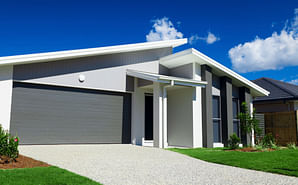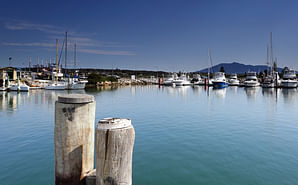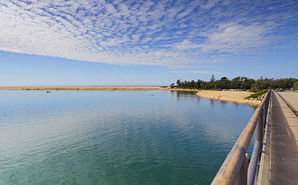Brogo Water Treatment Plant Upgrade
Upgrade of the Water Treatment Plant which services the Brogo-Bermagui network to improve water supply reliability and quality.
Project Summary/background
Bega Valley Shire Council has completed construction of the Brogo Water Treatment Plant (WTP). The WTP has improved the reliability and quality of drinking water to the Brogo-Bermagui system, which includes the townships of Quaama, Cobargo, Wallaga Lake and Bermagui, as well as rural customers connected to trunk mains.
The previous facility was made up of a chlorinator and balance tank, which only provided a single, disinfection treatment step to raw water from the Brogo River. While this served the community reasonably well for the past 30 years there are numerous occasions when boil water notices have been issued due to the quality of water in the Brogo River.
The recent bushfires over the 2019/2020 summer were a reminder of the vulnerability of the old water treatment process to changes in river water quality, with boil water notices and trucking from unaffected catchments in the south required at a significant cost.
The upgrade includes the introduction of a ‘filtration step’ using a Dissolved Air Flotation and Filtration (DAFF) unit. This unit will float suspended sediment and organics to the surface where they are removed before passing through a media filter. This will bring the water supplied to the Brogo-Bermagui into alignment with the Australian Drinking Water Guidelines.
As part of the upgrade, a fluoridation step is to be included at a later date, in accordance with the New South Wales Code of Practice for Fluoridation of Public Water Supplies. The upgrade also includes pump stations, water storage tanks and other water treatment equipment required to allow the WTP to operate.
Purpose
The key objective of the WTP upgrade is to improve water quality standards and water supply reliability to bring in line with the rest of NSW, by consistently providing clean and safe drinking water to the shire’s north.
Funding
Funded by the NSW Government's Safe and Secure Water Program $10.7m, with a Council contribution of $2.5m.
Connection to Council's Community Strategic Plan
This project is connect to Council's Community Strategic Plan through Outcome 3; Goal 6; Strategy 13 and Outcome 4; Goal 8; Strategy 18.
What has the planning process for the project involved?
GHD Pty Ltd was engaged by Council in the role of Owners Engineer for the upgrade of the WTP. This included preparing a Review of Environmental Factors (REF). The purpose of the REF is to describe the proposal, to document the likely impacts of the proposal on the environment, to detail mitigation measures to be implemented, and to determine whether the proposal can proceed. In doing so, the REF helped to fulfil the requirements of Section 5.5 of the Environmental Planning and Assessment Act 1979; that Council examine and take into account to the fullest extent possible all matters affecting or likely to affect the environment by reason of the activity.
Contract awarded
Council awarded the Design and Construct Contract to LC Water Pty Ltd. Construction commenced in August 2021 and was completed early 2023. Following a successful testing period, the new Brogo-Bermagui Water Treatment Plant was switched on and our northern customers are now connected to a reliable supply of clean and filtered water.
Who can I speak to:
Sam Watson
Project & Contract Management Officer
Bega Valley Shire Council
Phone: (02) 6499 2222
Email: council@begavalley.nsw.gov.au
Timeline of works
The timeline of the upgrade process is outlined below:
-
August 2020
Tender issued August 2020 and contract to be awarded in 2020.
-
January to August 2021
Detailed design.
-
August 2021
Commence construction.
-
Early 2023
Project complete, including construction, testing and commissioning. A reliable supply of clean and filtered water is now on tap for our northern cutomers.
Frequently Asked Questions
The new Brogo water treatment plant treats water using a three-step process:
1. Flocculation and aeration – which removes sediment by passing an electrical current through the water, causing particles to clump, rise to the top and be mechanically removed.
2. Filtration – which removes some chemicals and smaller particles left behind after flocculation.
3. Chlorination – which uses chlorine gas to provide a protective barrier against harmful bacteria, viruses and some protozoa.
We test river water quality monthly and sometimes more frequently to give us a good picture of microbiological, physical and chemical changes. On-line analysers continuously monitor river turbidity, chlorine residual and pH levels. Water quality in the distribution system is monitored weekly for E.coli and monthly for chemical parameters as part of the Bega Valley Drinking Water Quality Monitoring Program, overseen by NSW Health. Routine operational monitoring is also undertaken at various locations for chlorine residual and turbidity.
Brogo River water is of a high quality historically. The Brogo Dam catchment is National Park and Wilderness Area, and land-use downstream is limited to large area rural residential and lifestyle type farms. Turbidity is often below 2 NTU for prolonged periods in dry conditions, increasing along with colour and bacteria - like E.coli - following rainfall. The new water treatment plant will provide clean drinking water regardless of conditions and water quality in the Brogo River.
About 85% of the catchment was burnt in the Badja Forest Road Fire in early 2020, denuding ground cover, exposing soil and depositing ash, soot and other pyrolytic compounds throughout the catchment. Runoff from subsequent rain events washed this material downstream in river water. This caused some water quality indicators to be elevated for longer periods with each rainfall event, including turbidity, colour, alkalinity, dissolved organic carbon, total dissolved solids, hardness, nitrogen and phosphorous. A temporary settling plant was constructed at Upper Brogo after the bushfire to treat river water impacted by the bushfire and rainfall-runoff prior to supply. At drier times, however, river water quality has been similar to pre-bushfire times, for most indicators. The new water treatment plant will provide a reliable supply of clean drinking water, even during emergency events.
This will no longer be required now the new water treatment plant is up and running.
Boil water notices are issued when E.coli is detected in the distribution system, or more commonly as a precautionary measure when water with turbidity of more than 5 NTU is supplied from the river. 5NTU is the CCP limit agreed to by NSW Health for the supply of unfiltered chlorinated water from the Brogo River. Turbidity exceeding 5 NTU can shield micro-organisms from the oxidising effect of chlorine. Boiling water in these circumstances provides an added level of disinfection and reduces the risk of pathogens causing illness.
Water restrictions caused by heavy rain will no longer be required.
We previously stopped supplying water from the Brogo River when turbidity exceeded 5 NTU following rainfall. The temporary settling plant was used to treat the water in the days afterwards, however the quality required was not always attainable and throughput was sometimes slow, particularly for larger rainfall events. This caused town water reservoir levels to drop. Short-term water restrictions were sometimes introduced in these circumstances to slow the rate of water loss in the reservoirs and maintain water supply until the river recovered, or until supply met demand.
WTPs remove impurities and pathogens from water and ensure water is safe to drink, even when the source water quality deteriorates. The new Brogo WTP ensures that water supplied to customers now meets Australian Drinking Water Guidelines.
Yes, the plant is designed to supply safe drinking water to meet demand, even when the raw water quality is poor, up to 100 NTU. When the water quality deteriorates beyond 100 NTU, the plant is designed to operate at a reduced rate.
1. The new Brogo WTP is a Diffused Air Floatation & Filtration (DAFF) type plant. An outline of the process is:
2. Water is extracted from the Brogo River roughly 4km downstream of Brogo Dam
3. Soda ash (sodium carbonate) is added to the raw water to increase pH, if needed, for optimising coagulation
4. Alum (aluminium sulphate) or ACH (aluminium chlorohydrate) and polymer is added to the raw water to provide a static charge that attracts material in the water and form “floc” which grow with time during mixing in coagulation and flocculation tanks
The water containing the floc flows into a DAFF chamber where:
a) air entrained water is injected into the bottom of the chamber
b) microbubbles attach themselves to the floc and lift it to the surface
c) at the surface, a blanket of floc is mechanically skimmed off
d) clarified water flows through the bottom of the DAFF chamber through a filter media bed of anthracite, sand and gravel
Filtered water is pumped to a clear water tank and dosed with chlorine for disinfection, and soda ash to correct pH.
The clear water tank feeds the entire supply system via gravity.
Yes, but in much lower concentrations than previously used. The WTP will improve water clarity by removing turbidity and colour through coagulation, flocculation, floatation and filtration. Chlorine as an oxidant is more effective at killing bacteria and viruses in the clarified, filtered water.
Eventually, yes. Fluoride in the form of sodium silicofluoride will be dosed to achieve a concentration of 1 mg/L in the treated water, in accordance with NSW Health code of practice for fluoridation. Fluoride dosing and concentration is closely monitored and controlled. This will join Bega-Tathra in being the second fluoridated supply in the shire.
Fluoride will be added to the drinking water for improved dental health outcomes. The decision to include fluoride in Brogo's water supply system was made by Bega Valley Shire Council in 2018. Fluoride is currently added to water supplied by the Bega-Tathra water supply system.
News and Updates







